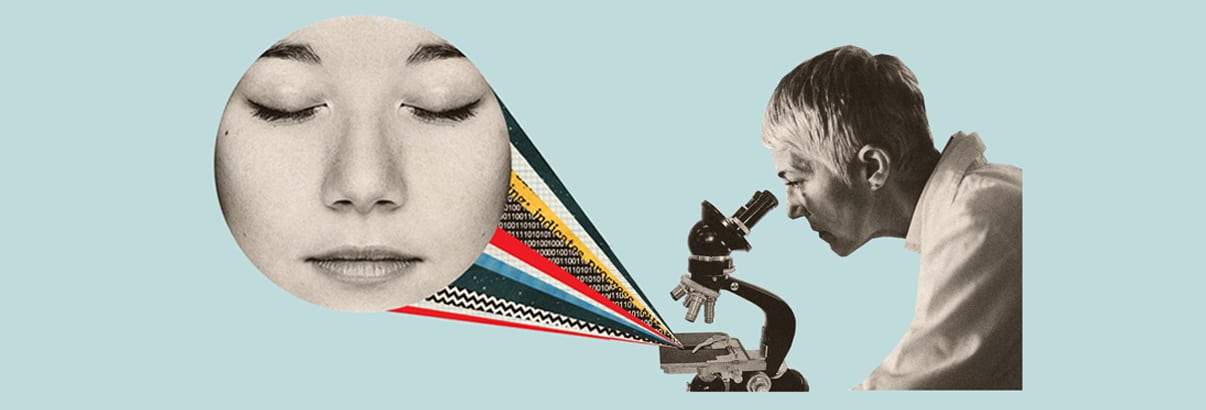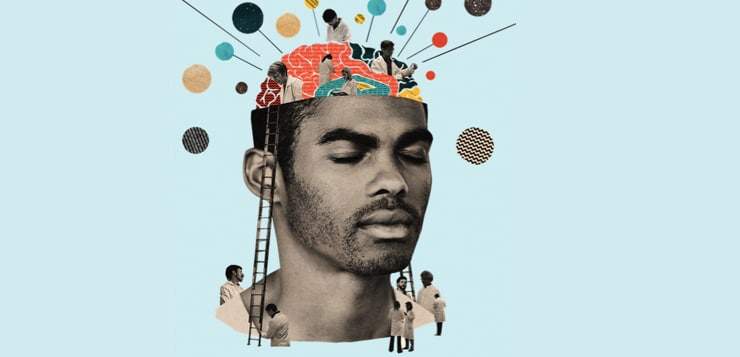Richie Davidson has always been a maverick. While other neuroscientists focused their attention on the mechanics of how to think harder and better, he was intrigued by a different question: What is a truly relaxed and focused mind capable of? His own practice of meditation and his encounters with experienced meditators offered him personal, anecdotal evidence for the profound effects of mindfulness and other kinds of practices, but could he demonstrate that in a laboratory setting? Davidson has devoted his career to that quest, which is chronicled in a new book written with Daniel Goleman, Altered Traits: Science Reveals How Meditation Changes Your Mind, Brain, and Body.
The neuroscience of meditation investigates the full range of practice, from beginners who’ve never meditated before to practitioners who’ve done extended training programs to adept Olympic-level meditators who’ve logged more than 12,000 lifetime hours of meditation. Mingyur Rinpoche, a 42-year-old meditation master and teacher, is the classic Olympic-level meditator, who also has an abiding interest in scientific investigation. By the time he arrived at Davidson’s lab at the University of Wisconsin in 2002, Mingyur had already amassed more than 62,000 hours of meditation, including 10 full years on retreat—the perfect candidate to demonstrate the long-term impact of repeated meditation practice. But even the unruffled, methodically exacting Davidson was surprised at what happened next.
During the first session, a researcher instructed Mingyur, who had been hooked up to an EEG machine, to practice meditation to generate compassion for 60 seconds, rest for 30 seconds, then repeat the cycle three more times. As soon as Mingyur started meditating, the team of researchers was stunned by the unprecedented surge of electrical activity that appeared on the computer screens. At first, they thought Mingyur must have moved his head slightly, a common problem with EEG machines, which are notoriously sensitive to body movements. But as the session continued, Mingyur remained motionless, and every time the signal to meditate came on, the computers came alive the same way. “The lab team knew at that moment they were witnessing something profound, something that had never before been observed in the laboratory,” write Davidson and Goleman in their book. “None could predict what this would lead to, but everyone sensed this was a critical inflection point in neuroscience history.”
For Goleman and Davidson, this moment was a long time coming. Both of them had become interested in meditation after spending time practicing in India when they were graduate students at Harvard in the 1970s. But they had difficulty convincing the powers that be in the psychology department to take the study of meditation seriously, in large part because it didn’t fit the behaviorist paradigm that was in vogue at the time. In fact, when Davidson proposed doing his PhD dissertation on meditation, his advisor warned him that it would be “a career-ending move.”
So they shifted focus. Davidson became an expert in affective neuroscience and performed several groundbreaking studies on emotions and the brain, while Goleman became a celebrated columnist for the New York Times and wrote several influential books, including his hallmark bestseller, Emotional Intelligence. Nevertheless, their interest in studying the effects of meditation persisted. A key turning point came in 2000, when Davidson and other scientists came together for a series of high-level discussions with the Dalai Lama on destructive emotions. At one point, the Dalai Lama turned to Davidson and challenged him to take some of the time-honored meditation practices that focus on taming these kinds of emotions and test them rigorously in the lab, devoid of their religious trappings. “And if you find that they’re of benefit to people,” Goleman recalls the Dalai Lama saying, “then spread them as widely as you can.”
The question that fascinated Goleman and Davidson was what were the lasting traits that meditation produces that go beyond the heightened states one often experiences in the session itself. From their point of view, meditation’s impact on health and performance was important, but even more intriguing was the role the practice played in cultivating enduring qualities, such as selflessness, equanimity, and impartial compassion. Back in their grad school days, Goleman and Davidson came up with a clever hypothesis to explain this phenomenon for a journal article they were writing: The after is the before for the next during. In this case, the after related to the internal changes that persist after a meditation session, the before was the baseline condition when we start meditating, and the during referred to the temporary changes that occur in the process. Says Goleman, “That was our way of talking about how, as you continue practicing, the things you saw happening during the state itself become part of your way of being. They become traits.”
It was an interesting theory. The only problem was they didn’t have any scientific research at the time to back it up. “We had the meditators,” he laments, “but we didn’t have the data.”
But now that’s changing. The latest research on long-term meditators is showing that Goleman and Davidson’s intuition wasn’t far off. These new studies are providing scientific confirmation that sustained practice can bring about enduring changes in brain function and the kind of transformation in behavior that, as they put it, “dramatically ups the limits on psychological science’s ideas of human possibility.”
Glimpsing the Mindful Brain
Much of the early research on meditation focused on “state” effects. The studies often involved novices who were taught mindfulness techniques and then tested against control groups to determine what impact, if any, the meditation had on their performance. Not all the research was that rigorous, and some turned out to be little more than hype. But when you weed out the studies that don’t meet the highest scientific standards, as Goleman and Davidson have done in their book, a clear picture emerges of what we know about the science of meditation—and what we still need to learn.
Not surprisingly, some of the strongest areas of research center on attention. In one key MIT study, researchers found that volunteers who took an eight-week Mindfulness-Based Stress Reduction program had a far greater ability to focus on their sensations than a control group that hadn’t done the training. Another study at the University of Wisconsin showed that only 10 minutes of breath-counting helped offset the damaging effects on concentration of heavy-duty multitasking. Still another study, from the University of California, Santa Barbara, revealed that merely eight minutes of mindfulness practice improved concentration and reduced mind-wandering. The researchers also found that mindfulness had a dramatic effect on working memory—the facility we have to manipulate stored information in order to reason and make decisions in a timely manner. One group of students that underwent a two-week course in mindfulness training boosted their scores on their GREs—the graduate school entrance exams—by more than 30%.
Stress is another area where the evidence is particularly convincing. In one landmark study, researchers at Emory University gave volunteers an eight-week course of mindfulness training, then showed them upsetting photos to see how they responded. The result? A significant lowering of activity in the amygdala, the part of the brain that triggers the freeze- fight-or-flight response.
A third area with solid results is the study of compassion. According to Davidson, compassion practices, such as loving-kindness meditation, work very quickly, sometimes producing effects in as little as eight days of practice. “That doesn’t mean these effects are going to last,” he says, “but it implies that kindness may be an intrinsic part of the mind. What the practice does is reacquaint us with that quality in ourselves so that we can make it more accessible.”
In one study at Davidson’s lab, a group of volunteers underwent a two-week program of compassion meditation and had their brains scanned while they looked at images designed to evoke empathy. Then they played a game in which they had to decide how much assistance to give victims who had been cheated by a crooked “dictator.” In the end, the volunteers who had gone through compassion training donated twice as much money to the victims as the control group. And their brain scans showed increased activity in circuits for attention, perspective taking, and positive feelings. Similarly, other studies have found that compassion meditation strengthens the connection between the prefrontal cortex and the brain’s circuits for joy and happiness.
One area where the results aren’t as promising is the medical research field. Although numerous studies have shown that MBSR and other methods can help reduce pain and anxiety, the track record isn’t as
good when it comes to curing medical syndromes or trying to unearth the causes of illness. There’s some evidence that short-term mindfulness training can decrease inflammation and that longer, more intensive programs can stimulate an increase in telomerase, the part of DNA that slows cellular aging. But after extensive review, Goleman and Davidson concluded that the best studies in the field focused primarily on reducing psychological distress, which may exacerbate the suffering caused by the illness, rather than on discovering underlying biological mechanisms.
How to Unstick the Self
Recently, researchers have begun to take a closer look at the impact of continued meditation on long-term practitioners. One of the most important discoveries is that repeated practice tends to make seasoned practitioners far less attached to the ongoing narratives we make up about ourselves. And that’s beginning to shed new light on the way brain circuits work.
One of the most important discoveries is that repeated practice tends to make seasoned practitioners far less attached to the ongoing narratives we make up about ourselves.
Although the brain makes up only about 2% of the body’s mass, it burns about 20% of the body’s metabolic energy, even when we’re doing nothing. Why? Because when we’re not focused on a specific mental task, the brain’s default mode network—the node connecting the prefrontal cortex to the limbic system—becomes highly active, weaving together thoughts, emotions, hopes, and dreams into a cohesive self-narrative. Meditation disrupts that process, training us to notice when our mind wanders and bring it back into focus. By doing that repeatedly, researchers speculate, we strengthen the connection between the prefrontal cortex and the default mode, and that quiets down the self-obsessed mind.
“We all carry around in our heads a narrative about ourselves that is associated with specific brain circuits,” says Davidson. “On one extreme, you can talk about someone with clinical depression who may really be ensnared by this narrative and take it at face value. But what we’ve learned with certain kinds of meditation practice is not to get rid of the narrative, but simply to change our relationship to it, to make it our friend rather than our enemy. That allows us not to get ensnared by the narrative so that we can develop a healthier sense of self.”
The research bears this out. In a Yale study, researcher Judson Brewer and his colleagues discovered that the default mode networks of highly experienced meditators (averaging 10,500 lifetime hours) were far less active than those of beginners, particularly when the former did loving-kindness practice, which shifted their focus away from themselves. In another study, Brewer’s team discovered that seasoned meditators were more likely than beginners to report experiencing “undistracted awareness” and “effortless doing.” In the final stage of letting go of self-referencing, Goleman and Davidson contend, the relationship to the self changes and is not so “sticky” anymore. “The same sorts of thoughts can arise in your mind,” they add, “but they are lighter: not so compelling, with less emotional oomph, and so float away more easily.”
In his studies of Mingyur and other long-term practitioners (averaging 27,000 lifetime hours of practice), Davidson was impressed by their extraordinary gifts for emotional regulation. This was particularly true when they experienced intense pain. During one study, the long-term practitioners and a control group were given a ten-second blast of heat from a thermal stimulator, preceded by a 10-second warning. As soon as the warning started, the control group’s brains went wild, registering almost as much pain as when the burning sensation happened. The study subjects, in contrast, showed no reaction to the warning sign, but exhibited a far more intense response to the heat itself. And when the heat stopped, they recovered far more quickly than the control group.
“This inverted-V pattern, with little reaction during anticipation of a painful event, followed by a surge of intensity at the actual moment, then swift recovery from it, can be highly adaptive,” write Goleman and Davidson. “This lets us be fully responsive to a challenge as it happens, without letting our emotional reactions interfere before or afterward, when they are no longer useful.”
One of the most surprising things about the long-term practitioners was their extremely high levels of gamma-wave oscillation not only during meditation, but while they were resting, as well. Bursts of gamma waves are usually rare occurrences, showing up for split seconds when the brain regions suddenly click together in harmony. But Davidson and his colleague, Antoine Lutz, found that high-amplitude gamma patterns were part of their everyday neural activity. Their baseline readings before they started meditating, for instance, were 25 times greater than those of the control group.
For Goleman and Davidson, this discovery was, in their words, like stumbling upon “the holy grail.” It meant that these long-term practitioners were able to experience an ongoing state of open awareness in their daily lives. They described it as a kind of “spaciousness and vastness,” as if “all their senses were wide open to the full, rich panorama of experience.” This finding was, as the authors put it, the first “neural echo of the enduring transformations that years of meditation practice etch on the brain. Here was the treasure, hidden in the data all along: a genuine altered trait.”
Where Do We Go from Here?
Davidson is used to encountering skepticism whenever he publishes results of a new study. “One kind of push-back I get is that I’m not an objective observer and our data can’t be trusted because I’ve admitted publicly that I am a meditator,” he says. “I love that comment. It’s like telling a cardiologist who studies the heart that he can’t do any exercise for the remainder of his professional life.” Some of the scientific papers he’s most proud of, he adds, are the ones that failed to show any difference between meditators and controls. An example: Several years ago, Davidson’s lab was unable to replicate a study that made national headlines showing that meditation slows the shrinkage of the brain as we age.
Another common form of criticism is that the research isn’t that good, and there’s a lot more hype in the findings than real evidence. In general, Davidson would agree with that assessment. When his research team was looking for studies on loving-kindness to include in the book, for example, they found only 37 out of 231 that met the highest standards of experimental design. And David- son winnowed the list down to eight when he added another filter: the importance of the findings.
One of the biggest problems with meditation research is the lack of consensus on what the term “mindfulness” means. Mindfulness expert Jon Kabat-Zinn articulated the most widely used definition: “The awareness that emerges through paying attention on purpose, in the present moment, and nonjudgmentally to the unfolding of experience.” But that definition doesn’t capture the complexity of the concept across other meditation disciplines. And scientists who aren’t familiar with the nuances of practice often use “mindfulness” and “meditation” interchangeably. “To me, the fact that there are different definitions is not so much a problem as long as we’re clear about which definition we’re using and, more importantly, what specific measures we’re employing to capture that metric,” says Davidson. “As long as we are clear about that and restrict the claims we’re making to that specific variation of mindfulness, we’ll be okay. When we use the term to mean mindfulness in general, that’s when the problems creep in.”
Eventually, Davidson believes, future research will lead to a much more personalized approach to meditation: “We will be able to specify with more precision which kinds of practices will be most helpful for which kinds of people.”
Another problem is the lack of in-depth longitudinal studies, which track subjects’ progress over extended periods of time. One particular hole, according to Goleman and Davidson, is the paucity of research on the long-range impact of meditation on self-attachment. Those kinds of studies are expensive and time consuming. But, at some point, Goleman envisions that researchers will have the technological capability to monitor meditators in their daily lives, not just in the lab, and see how they respond to real-life events as they’re taking place.
One area that needs more study is the effect of duration of practice. Certain kinds of biological changes, for example, are more closely associated with retreat practice than with daily practice. But it’s unclear whether it’s the long hours of practice, the community support, or other factors that produce the results. There’s not much good research on length of practice either. If a new meditation student decides to allocate 20 minutes a day to practice, should he or she do all 20 minutes in a single session or four five-minute sessions or even 10 two-minute sessions? “Right now we have absolutely no idea what the optimal strategy for producing enduring change is,” says Davidson. “These are critical questions that can be addressed scientifically and need to be if this work is really going to have broad impact.”
The good news is that it doesn’t take much time meditating to generate measurable results. “We’ve shown in the laboratory that meditating for a half hour a day for two weeks is enough to produce changes in the brain,” he adds. “Most people recognize that if you go to the gym for two weeks and work out every day with a personal trainer, you’ll feel a difference. But those changes aren’t going to persist unless you keep exercising. Meditation is very similar. It’s a form of mental exercise. And once you begin to experience beneficial changes, it will inspire you to continue practicing for the rest of your life.”
Eventually, Davidson believes, future research will lead to a much more personalized approach to meditation. As our scientific knowledge of how meditation works expands, he predicts, “we will be able to specify with more precision which kinds of practices will be most helpful for which kinds of people.” This is not unlike the revolution that’s currently underway in medicine, where doctors are prescribing treatments based on patients’ genetic makeup. But, in the case of meditation, Davidson thinks the practices will be based on a configuration of your cognitive and emotional strengths and weaknesses—a profile of your well-being.
That idea excites Davidson. “In this historical era,” he says, “I think we have a moral obligation to bring these practices to as many people as we can, to heal the world and cultivate a more collective kind of warm-heartedness, which I think most people would agree the world could use more of. It’s akin, I think, to what the climate scientists are doing. We can’t just collect data and sit in our labs anymore.”
“In most parts of the world today, people practice some kind of personal physical hygiene,” he continues. “My aspiration is that people will care for their minds in the same way. They will engage in simple practices that will be disseminated very widely. I’m convinced the world would be a very different place if we can cross that tipping point.”
Definition: What is Mindfulness?
Everyone thinks they know what it means, and that’s part of the problem.
Mindfulness now carries a broad, popular—and therefore inevitably loose—definition. It’s used to refer to generally paying attention in life, but it also carries more precise definitions, including a human capability of being aware of one’s own mind, body, and surroundings, as well as practices to cultivate that capability.
Scientific research cannot rely on the broad definitions in common parlance. Researchers require an empirical definition, one that is not philosophical or spiritual and points to something as concrete and measurable as possible.
One of the first elements of a definition of mindfulness is to distinguish mindfulness practice (the instruction given as a means to foster inherent mindfulness) from mindfulness as a basic human quality or ability.
A further distinction exists in the literature between “state mindfulness” (the immediate experience of being mindful) and “trait mindfulness” or “dispositional mindfulness” (lasting habits that indicate one is being more mindful in daily life). One of the most common definitions of state mindfulness is from Jon Kabat-Zinn: “Mindfulness is the awareness that arises by paying attention, on purpose, in the present moment, and nonjudgmentally.”
In the laboratory, another component of the definition of mindfulness concerns the instructions subjects are given when they are asked to “practice mindfulness.”
Once you’ve defined “mindfulness,” the next biggest challenge is measuring it, through either “self-report” questionnaires that usually focus on trait mindfulness (how mindful you are in daily life) or technologies such as EEGs and fMRIs that measure brain activity to try to identify “states” of mindfulness or long-term alterations in brain function.
A very significant paper was published by four leading researchers in the October 2015 issue of American Psychologist (“Investigating the Phenomenological Matrix of Mindfulness-related Practices from a Neurocognitive Perspective”) that approached defining mindfulness not by trying to arrive at a single definition, but rather by mapping it as a “continuum of practices involving states and processes.” It delves into, for example, the differences between practices that emphasize “focused attention” from those that emphasize “open monitoring.” While both of these are often called “mindfulness,” the first emphasizes focusing on a specific object while the second encourages generalized awareness, and what is cultivated will likely differ.
This article appeared in the December 2017 issue of Mindful magazine.
Read More
10 Mindfulness Researchers You Should Know
Key insights from leading researchers spotlight what we know, what we don’t know, and what the future holds for the science of mindfulness.
Read More
What Is Mindfulness?
Are you supposed to clear your mind, or focus on one thing? Here’s the Mindful definition of mindfulness.
Read More








